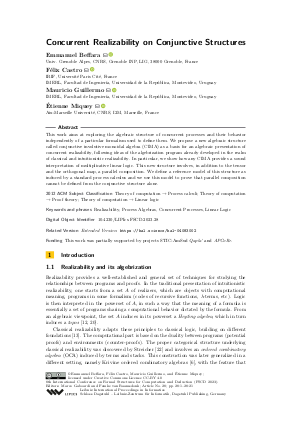Concurrent Realizability on Conjunctive Structures
Authors
Emmanuel Beffara  ,
Félix Castro
,
Félix Castro  ,
Mauricio Guillermo
,
Mauricio Guillermo  ,
Étienne Miquey
,
Étienne Miquey 
-
Part of:
Volume:
8th International Conference on Formal Structures for Computation and Deduction (FSCD 2023)
Part of: Series: Leibniz International Proceedings in Informatics (LIPIcs)
Part of: Conference: Formal Structures for Computation and Deduction (FSCD) - License:
 Creative Commons Attribution 4.0 International license
Creative Commons Attribution 4.0 International license
- Publication Date: 2023-06-28
File

PDF
LIPIcs.FSCD.2023.28.pdf
- Filesize: 0.89 MB
- 21 pages
Document Identifiers
Related Versions
- Extended Version https://hal.science/hal-04083002
Subject Classification
ACM Subject Classification
- Theory of computation → Process calculi
- Theory of computation → Proof theory
- Theory of computation → Linear logic
Keywords
- Realizability
- Process Algebras
- Concurrent Processes
- Linear Logic
Metrics
- Access Statistics
-
Total Accesses (updated on a weekly basis)
0PDF Downloads0Metadata Views
Abstract
This work aims at exploring the algebraic structure of concurrent processes and their behavior independently of a particular formalism used to define them. We propose a new algebraic structure called conjunctive involutive monoidal algebra (CIMA) as a basis for an algebraic presentation of concurrent realizability, following ideas of the algebrization program already developed in the realm of classical and intuitionistic realizability. In particular, we show how any CIMA provides a sound interpretation of multiplicative linear logic. This new structure involves, in addition to the tensor and the orthogonal map, a parallel composition. We define a reference model of this structure as induced by a standard process calculus and we use this model to prove that parallel composition cannot be defined from the conjunctive structure alone.
Cite As Get BibTex
Emmanuel Beffara, Félix Castro, Mauricio Guillermo, and Étienne Miquey. Concurrent Realizability on Conjunctive Structures. In 8th International Conference on Formal Structures for Computation and Deduction (FSCD 2023). Leibniz International Proceedings in Informatics (LIPIcs), Volume 260, pp. 28:1-28:21, Schloss Dagstuhl – Leibniz-Zentrum für Informatik (2023)
https://doi.org/10.4230/LIPIcs.FSCD.2023.28
BibTex
@InProceedings{beffara_et_al:LIPIcs.FSCD.2023.28,
author = {Beffara, Emmanuel and Castro, F\'{e}lix and Guillermo, Mauricio and Miquey, \'{E}tienne},
title = {{Concurrent Realizability on Conjunctive Structures}},
booktitle = {8th International Conference on Formal Structures for Computation and Deduction (FSCD 2023)},
pages = {28:1--28:21},
series = {Leibniz International Proceedings in Informatics (LIPIcs)},
ISBN = {978-3-95977-277-8},
ISSN = {1868-8969},
year = {2023},
volume = {260},
editor = {Gaboardi, Marco and van Raamsdonk, Femke},
publisher = {Schloss Dagstuhl -- Leibniz-Zentrum f{\"u}r Informatik},
address = {Dagstuhl, Germany},
URL = {https://drops.dagstuhl.de/entities/document/10.4230/LIPIcs.FSCD.2023.28},
URN = {urn:nbn:de:0030-drops-180124},
doi = {10.4230/LIPIcs.FSCD.2023.28},
annote = {Keywords: Realizability, Process Algebras, Concurrent Processes, Linear Logic}
}
Author Details
- IRIF, Université Paris Cité, France
- IMERL, Facultad de Ingeniería, Universidad de la República, Montevideo, Uruguay
Funding
This work was partially supported by projects STIC-AmSud Qapla' and APCoRe.
References
- Samson Abramsky, Esfandiar Haghverdi, and Philip Scott. Geometry of interaction and linear combinatory algebras. Mathematical Structures in Computer Science, 12(5):625-665, 2002. URL: https://doi.org/10.1017/S0960129502003730.
-
Emmanuel Beffara. Logique, réalisabilité et concurrence. PhD Thesis, Université Paris 7, December 2005.

-
G. Birkhoff. Lattice theory, volume 25 of Colloquium publications. American Mathematical Society, 1940.

- Pierre-Louis Curien and Hugo Herbelin. The duality of computation. In Proceedings of ICFP 2000, SIGPLAN Notices 35(9), pages 233-243. ACM, 2000. URL: https://doi.org/10.1145/351240.351262.
- Étienne Duchesne. La localisation en logique : géométrie de l'interaction et sémantique dénotationnelle. Thèse de doctorat, Université Aix-Marseille 2, 2009. URL: http://www.theses.fr/2009AIX22080.
- Walter Ferrer Santos, Jonas Frey, Mauricio Guillermo, Octavio Malherbe, and Alexandre Miquel. Ordered combinatory algebras and realizability. Mathematical Structures in Computer Science, 27(3):428-458, 2017. URL: https://doi.org/10.1017/S0960129515000432.
-
Yuxi Fu. The χ-Calculus. In 1997 Advances in Parallel and Distributed Computing Conference (APDC), pages 74-81. Computer Society Press, 1997.

- Jean-Yves Girard. Linear logic. Theoretical Computer Science, 50(1):1-101, 1987. URL: https://doi.org/10.1016/0304-3975(87)90045-4.
- Jean-Yves Girard. Locus Solum: From the rules of logic to the logic of rules. Mathematical Structures in Computer Science, 11(3):301-506, June 2001. URL: https://doi.org/10.1017/S096012950100336X.
-
Kohei Honda and Nobuko Yoshida. Combinatory representation of mobile processes. In ACM-SIGACT Symposium on Principles of Programming Languages, 1994.

-
Kohei Honda and Nobuko Yoshida. Replication in concurrent combinators. In Masami Hagiya and John C. Mitchell, editors, Theoretical Aspects of Computer Software, pages 786-805, Berlin, Heidelberg, 1994. Springer Berlin Heidelberg.

- J.M.E. Hyland. The effective topos. Studies in Logic and the Foundations of Mathematics, 110:165-216, 1982. The L. E. J. Brouwer Centenary Symposium. URL: https://doi.org/10.1016/S0049-237X(09)70129-6.
-
J.-L. Krivine. Realizability in classical logic. In Interactive models of computation and program behaviour. Panoramas et synthèses, 27:197-229, 2009. Publisher: Société Mathématique de France.

- Jean-Louis Krivine. Realizability algebras II : new models of ZF + DC. Logical Methods in Computer Science, 8(1):10, February 2012. 28 p. URL: https://doi.org/10.2168/LMCS-8(1:10)2012.
- Alexandre Miquel. Implicative algebras: a new foundation for realizability and forcing. Mathematical Structures in Computer Science, 30(5):458-510, 2020. URL: https://doi.org/10.1017/S0960129520000079.
- Étienne Miquey. Revisiting the Duality of Computation: An Algebraic Analysis of Classical Realizability Models. In Maribel Fernández and Anca Muscholl, editors, 28th EACSL Annual Conference on Computer Science Logic (CSL 2020), volume 152 of Leibniz International Proceedings in Informatics (LIPIcs), pages 30:1-30:18, Dagstuhl, Germany, 2020. Schloss Dagstuhl-Leibniz-Zentrum fuer Informatik. URL: https://doi.org/10.4230/LIPIcs.CSL.2020.30.
- Guillaume Munch-Maccagnoni. Focalisation and Classical Realisability. In Erich Grädel and Reinhard Kahle, editors, Computer Science Logic '09, volume 5771 of Lecture Notes in Computer Science, pages 409-423. Springer, Heidelberg, 2009. URL: https://doi.org/10.1007/978-3-642-04027-6_30.
-
Guillaume Munch-Maccagnoni. Syntax and Models of a non-Associative Composition of Programs and Proofs. PhD thesis, Univ. Paris Diderot, 2013.

-
Joachim Parrow and Björn Victor. The Fusion Calculus: Expressiveness and Symmetry in Mobile Processes. In 13th IEEE Symposium on Logic in Computer Science (LICS), pages 176-185, 1998.

- Andrew M. Pitts. Tripos theory in retrospect. Mathematical Structures in Computer Science, 12(3):265-279, 2002. URL: https://doi.org/10.1017/S096012950200364X.
-
Davide Sangiorgi and David Walker. The π-Calculus: A Theory of Mobile Processes. Cambridge University Press, 2001.

- Thomas Streicher. Krivine’s classical realisability from a categorical perspective. Mathematical Structures in Computer Science, 23(6):1234-1256, 2013. URL: https://doi.org/10.1017/S0960129512000989.
- Lucian Wischik and Philippa Gardner. Explicit fusions. Theoretical Computer Science, 340(3):606-630, August 2005. URL: https://doi.org/10.1016/j.tcs.2005.03.017.
